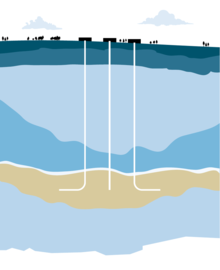Storage technology
Because of the large distances between the production fields and the consumers technical and economic issues make it impossible to balance the large seasonal fluctuations in demand. To guarantee a balance between the flat flow of Natural Gas which is purchased and the volatile demand of the customers it is necessary to store the natural gas.
Gas storage in surface storage facilities, so-called high pressure gas tanks or pipe storage facilities, is inadequate because of the very limited capacity that is available. Much larger storage volumes can be provided underground – and here we basically distinguish between two different types of underground storage facilities.
The utilization of natural gas storage facilities guarantees stable availability of this environment-friendly energy medium by balancing out natural gas production and consumption. During peak consumption periods additional natural gas volumes can be injected into the network and during times of low demand any surplus volumes can be stored. Volumes not used in the summer period could be injected in such a facility and then later on withdrawn to supply customers in the high-consumption winter months. This is described as seasonal adjustment. In addition to the original long-term task of seasonal adjustment storage facilities are also becoming increasingly sought after to optimize the natural gas portfolio.
Pore storage facilities
Pore storage facilities are natural rock formations, usually porous sandstone or limestone formations. The storage properties are due to the geological structure of the rock in which the natural gas can be stored – similar to a sponge soaking up water. In addition to the structure and stratification of the formation the spatial distribution of the cavities also plays an important role. The impermeable cap rock and neighbouring geological formations prevent the natural gas from escaping. Important pore storage facilities that are used to store natural gas are depleted natural gas or oil reservoirs. Most of these reservoirs have been thoroughly investigated from a geological aspect and the storage characteristic of the porous rock is known. One special type of pore storage is aquifer storage, in which the pores are filled with mineralised water. This water is slowly displaced by the Natural Gas to be stored and pressed into the bottom part of the structure. Requirements for this are thick cap rock or so-called anticlines or trap structures, which prevent the stored natural gas spreading into other layers.
Cavern storage facilities
Caverns are artificially created hollows in salt domes which can have a volume of up to a million cubic metres. The salt caverns which have been built in Germany are usually at a depth of between 700 and 2,000 metres and are cylindrical in shape. The diameter and length of the caverns varies from location to location and mainly depend on the geological structure of the salt dome. With the help of compressors the natural gas is pressed into the caverns at high pressure – a maximum working pressure of 250 bars can be reached (dependent on the location). The cavern storage facilities retain the natural gas due to the favourable petrophysical properties of the surrounding salt rocks.



